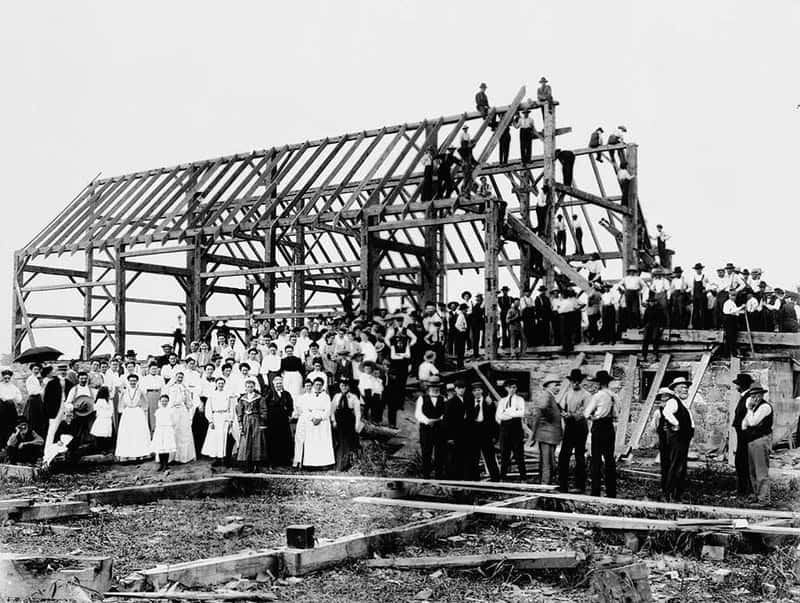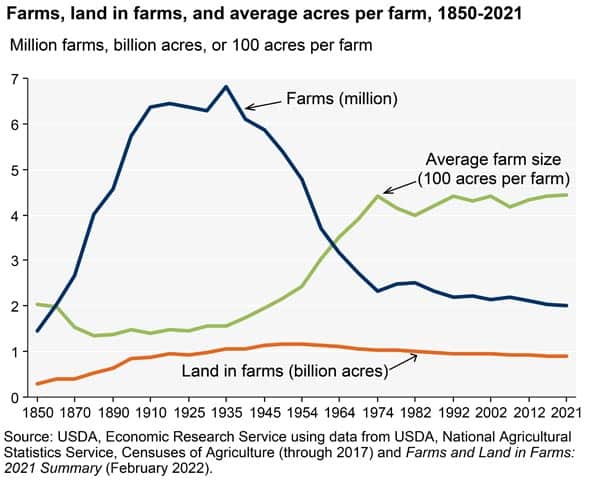If you have ever seen an Amish barn raising in real life, or in a movie like Witness, you were probably amazed to see a huge barn built in a single day.
Barn raising used to be a common activity in America, but today it only survives in a few communities, most of which are Amish. Here you will learn the history of barn-raising traditions, some of the surprising mental health benefits of modern Amish barn raising, and some modern-day alternatives if you need a barn built quickly.
History of Barn Raising in North America

Barn raising used to be common in 18th– and 19th-century America and Canada. Most people who lived in rural areas were farmers, and most farmers needed a barn to store hay and feed and to provide shelter for their animals. But building a barn without the aid of modern machines was a huge task. So when a farmer needed a barn, he would prepare all the materials needed to build the barn, and then organize a barn-raising party.
Although neighbors who came to help usually didn’t receive any pay, they could expect others would help them when they had a project too large to be done alone. This type of community work party was not limited to building barns. Often neighbors helped each other with labor-intensive tasks like harvesting and bailing hay, either for free or in exchange for goods or services.
The Decline of Barn Raising
Many factors have contributed to the decline and near extinction of the barn-raising tradition in America, including changes in financing, technology, and industry.
One factor was financing. Over time many people started hiring people to build their barns. In 1916 Congress passed the Federal Farm Loan act, which made agricultural loans more affordable and available. Affordable agricultural financing helped make it possible to pay for farm expenses like barn construction with a loan rather than needing to rely on the goodwill of neighbors.
Technology was another factor that contributed to the decline of barn raising. Advances in technology, like the invention of hydraulic cranes, power tools, and new building techniques made building barns easier and reduced the need for manual labor. The popularization of prefabricated trusses also greatly sped up the on-site building process.
A third factor that hurt the barn-raising tradition was industrialization. Industrialization in America reduced the need for manual labor on the farm and at the same time created many new non-farming job opportunities. Between the mid-1930’s and the mid-1970s, many people left their rural family farms and moved to cities to work in the manufacturing and service sectors. Small farms were consolidated into larger farms and many farm workers were replaced with machines.

With fewer small farms, fewer families needed a traditional barn. And as people left rural areas for jobs in cities, there were fewer and fewer people left in rural areas to lend a helping hand to their neighbors.
Amish Barn Raising
The tradition of barn raising continues today in Amish communities. The Amish are a Christian sect that chooses to avoid many modern technologies in order to preserve their religious values and the unity of their communities.
Most Amish don’t use cars. Instead, they use horses and buggies to get around. As a result, they must live near each other to remain part of the community and attend church services. Many Amish are also farmers, which is an ideal profession for a lifestyle that limits their use of technology. In these close-knit communities, the Amish value community and selflessness.
Amish barn raising is one example of the Amish tradition of “frolics.” A frolic is any kind of volunteer group work project that involves getting work done for someone and enjoying food and fellowship at mealtime.
Before an Amish barn raising begins, any foundation that is required is usually laid in advance, and all the materials needed for raising the barn are prepared. On the day of the barn raising, families of men, women, and children arrive in buggies early in the morning. The construction is led by a few men who organize the activities of all the other men who are helping. Young children play, watch, and learn, and the women prepare the meals for the day. At mealtime everyone enjoys good food and time to visit with friends and relatives.
Usually, the frame of the barn is raised in a single day, but it may take additional labor later to complete the building.
Mental Health Benefits of Amish Barn Raising
While many people in modern society are plagued with loneliness and depression, these problems are quite rare in Amish communities. Barn raising and other frolics give the Amish opportunities to bond together through shared work and face-to-face communication during shared meals. As much as we might appreciate contacting friends and family on Facebook, it just isn’t the same as the bonding that happens when we come together to accomplish something bigger than we could accomplish by ourselves.
Barn raising also helps give the Amish a sense of security, since they know that others will be there to help them in times of need. If an Amish family loses their home in a fire, the community will work together to quickly build them a new home. Insurance can also give us peace of mind, but only in an impersonal way.
Even though most of us don’t live in close-knit neighborhoods of relatives and friends, we can still participate in activities similar to barn raising and get some mental health benefits from serving and socializing with others. If you belong to a church, perhaps you can join or organize a volunteer work party to help someone in need. You can also find and participate in community service projects and humanitarian building projects like Habitat for Humanity.
Prefab Barn Raisings Today
Do you need a barn-raising party to build a barn on your property? While we don’t organize Amish barn raisings, we can organize a one-day prefab barn raising. Our prefab metal barns and buildings are usually installed in a single day by a work crew—which is almost as amazing to watch as a good old Amish barn raising.

